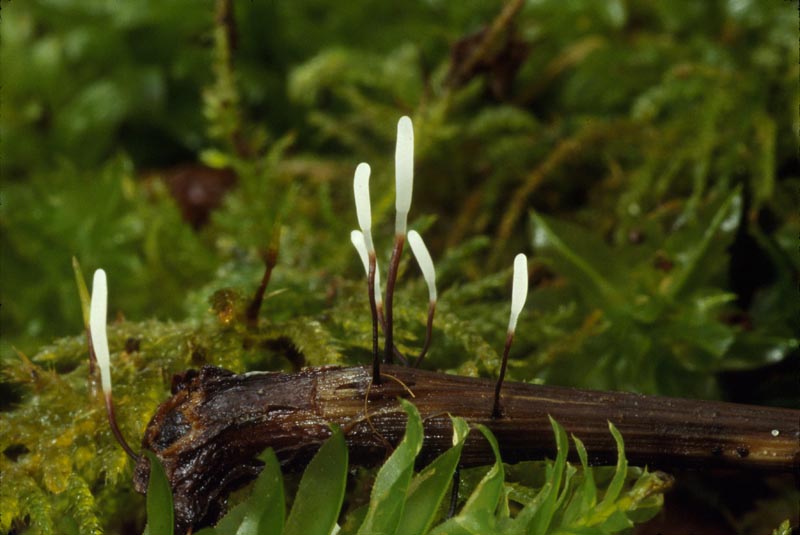
© Steve Trudell
Danny’s DNA Discoveries – Typhula of the PNW
by Danny Miller
|
|
Danny’s DNA Discoveries – Typhula of the PNW
|
|
Introduction
This relatively basal genus of the Agaricales has a number of very thin club mushrooms with irregularly lobed to spherical sclerotia (not flattened or absent as in the similar Macrotyphula). It may need its own sub-order. Some species were recently moved to Macrotyphula when it was discovered through DNA that that genus did not only contain species without sclerotia, but also those species with flattened sclerotia. abundant common uncommon rare - colour codes match my Pictorial Key and are my opinions and probably reflect my bias of living in W WA. Rare species may be locally common in certain places at certain times. |
|
Typhula (Typhulaceae)
Typhula cf incarnata EU - a couple cm tall with a pale pinkish head, parasitic on cereals and grasses. You will see just the sclerotia in spring, and the fruit bodies in fall. It is now the type species since T. phacorrhiza ended up moving to Macrotyphula. Olariaga provides a sequence of what this probably is, but we have no local sequences yet to compare to find out what our local reports of it really are. Typhula abietina EU - very small, only several mm tall, with a yellow-brown head and irregularly lobed brown sclerotium on conifer debris. No DNA yet. Typhula cystidiophora OR - A cream coloured club up to 5 cm tall coming from a dark brown sclerotium on the ground. Berthier moved this to Pseudotyphula which is thought to be in the suborder Marasmiineae. We have no DNA yet to know where this really belongs. Typhula erumpens BC - multiple white clubs a few mm tall come from each sclerotium under hardwood bark. No DNA yet. Typhula cf erythropus EU - a white head a couple cm high on a dark red-brown stem and sclerotium. The stem is longer than the head. Olariaga provides a sequence of what this probably is, but we have no local sequences yet to compare to find out what our local reports of it really are. Typhula PNW04 - resembles T. erythropus (in colouration and the fact that the stems are sometimes longer than the head) but differs by >5%, mostly in ITS1, which is odd. Found once in OR. Typhula idahoensis ID - another parasite of cereals and grasses that shows sclerotia in spring and fruit bodies in fall, with a warm brown head, dark brown stem, and almost black sclerotium, growing about 1 cm tall. One sequence from somewhere on the planet was labeled this, but it's not a reliable sequence. We need local collections. Typhula cf ishikariensis JP - very similar to T. idahoensis, but with pale greyish-white clubs. There are 2 genetic sister species going by this name in Japan, neither of which have been found in the PNW yet, although this species has been reported from here. Typhula PNW02 - one BC sequence was mistaken for T. ishikariensis and is a sister species to that, so this species may represent what reports of T. ishikariensis are in the PNW. Typhula mycophaga BC - grows on puffballs, up to 1 cm tall with a white head and rusty chestnut sclerotium. No DNA yet. Typhula cf sclerotioides EU - usually <1 cm tall, with a whitish head and stem and a dark brown sclerotium, growing on herbaceous stems and leaves. Olariaga provides a sequence of what this probably is, but we have no local sequences yet to compare to find out what our local reports of it really are. Typhula cf setipes UK? - with a whitish head and pale greyish-brown stem, sometimes without noticeable sclerotia, a few mm tall on hardwood leaves. We have one sequence from the EU purporting to be this, but it may not be reliable. No local DNA either to confirm the reports that it is here. Typhula cf thaxteri CT - too small to see with the naked eye, only 60 to 80 microns tall with a round head, white. No DNA yet. Typhula umbrina BC and Ontario - about 1 cm tall, white to brown head on a reddish to greyish brown stem and chestnut coloured sclerotium. Found on turnip plants in BC. No DNA yet. Typhula PNW03 - one WA collection matches nothing else in GenBank so far. unsequenced Typhula erythropus © Steve Trudell, unsequenced Typhula setipes © Fred Rhoades, T. PNW03 © Matthew Koons, T. PNW04 © Leah Bendlin
Typhulaceae PNW01 ('Lentaria' albovinacea EU) - This clean white coral has been bounced around from Clavicorona to Clavaria to Lentaria. LSU finally shows it belongs in or near Typhula. We now have ITS too. Typhulaceae PNW01 ('Lentaria' albovinacea) © Michael Beug |